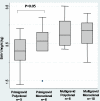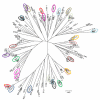Plasmodium falciparum population dynamics in a cohort of pregnant women in Senegal
- PMID: 20553578
- PMCID: PMC2893538
- DOI: 10.1186/1475-2875-9-165
Plasmodium falciparum population dynamics in a cohort of pregnant women in Senegal
Abstract
Background: Pregnant women acquire protective antibodies that cross-react with geographically diverse placental Plasmodium falciparum isolates, suggesting that surface molecules expressed on infected erythrocytes by pregnancy-associated malaria (PAM) parasites have conserved epitopes and, that designing a PAM vaccine may be envisaged. VAR2CSA is the main candidate for a pregnancy malaria vaccine, but vaccine development may be complicated by its sequence polymorphism.
Methods: The dynamics of P. falciparum genotypes during pregnancy in 32 women in relation to VAR2CSA polymorphism and immunity was determined. The polymorphism of the msp2 gene and five microsatellites was analysed in consecutive parasite isolates, and the DBL5epsilon + Interdomain 5 (Id5) part of the var2csa gene of the corresponding samples was cloned and sequenced to measure variation.
Results: In primigravidae, the multiplicity of infection in the placenta was associated with occurrence of low birth weight babies. Some parasite genotypes were able to persist over several weeks and, still be present in the placenta at delivery particularly when the host anti-VAR2CSA antibody level was low. Comparison of diversity among genotyping markers confirmed that some PAM parasites may harbour more than one var2csa gene copy in their genome.
Conclusions: Host immunity to VAR2CSA influences the parasite dynamics during pregnancy, suggesting that the acquisition of protective immunity requires pre-exposure to a limited number of parasite variants. Presence of highly conserved residues in surface-exposed areas of the VAR2CSA immunodominant DBL5epsilon domain, suggest its potential in inducing antibodies with broad reactivity.
Figures





Similar articles
-
Insight into antigenic diversity of VAR2CSA-DBL5ε domain from multiple Plasmodium falciparum placental isolates.PLoS One. 2010 Oct 1;5(10):e13105. doi: 10.1371/journal.pone.0013105. PLoS One. 2010. PMID: 20957045 Free PMC article.
-
Genetic diversity of VAR2CSA ID1-DBL2Xb in worldwide Plasmodium falciparum populations: impact on vaccine design for placental malaria.Infect Genet Evol. 2014 Jul;25:81-92. doi: 10.1016/j.meegid.2014.04.010. Epub 2014 Apr 21. Infect Genet Evol. 2014. PMID: 24768682
-
VAR2CSA binding phenotype has ancient origin and arose before Plasmodium falciparum crossed to humans: implications in placental malaria vaccine design.Sci Rep. 2019 Nov 18;9(1):16978. doi: 10.1038/s41598-019-53334-8. Sci Rep. 2019. PMID: 31740695 Free PMC article.
-
Cytoadhesion of Plasmodium falciparum-infected erythrocytes and the infected placenta: a two-way pathway.Braz J Med Biol Res. 2006 Dec;39(12):1525-36. doi: 10.1590/s0100-879x2006001200003. Braz J Med Biol Res. 2006. PMID: 17160261 Review.
-
Designing a VAR2CSA-based vaccine to prevent placental malaria.Vaccine. 2015 Dec 22;33(52):7483-8. doi: 10.1016/j.vaccine.2015.10.011. Epub 2015 Nov 26. Vaccine. 2015. PMID: 26469717 Free PMC article. Review.
Cited by
-
Parasite dynamics in the peripheral blood and the placenta during pregnancy-associated malaria infection.Malar J. 2016 Sep 21;15(1):483. doi: 10.1186/s12936-016-1541-x. Malar J. 2016. PMID: 27653788 Free PMC article.
-
Factors influencing the use of malaria prevention strategies by women in Senegal: a cross-sectional study.Malar J. 2017 Nov 21;16(1):470. doi: 10.1186/s12936-017-2095-2. Malar J. 2017. PMID: 29157243 Free PMC article.
-
Epidemiology and Risk Analysis of Malaria among Pregnant Women.Iran J Public Health. 2012;41(1):1-8. Epub 2012 Jan 31. Iran J Public Health. 2012. PMID: 23113116 Free PMC article.
-
Plasmodium falciparum genotypes in matched peripheral, placental and umbilical cord blood in an area characterised by unstable malaria transmission in eastern Sudan.Heliyon. 2017 Jun 15;3(6):e00326. doi: 10.1016/j.heliyon.2017.e00326. eCollection 2017 Jun. Heliyon. 2017. PMID: 28653041 Free PMC article.
-
Measuring changes in Plasmodium falciparum transmission: precision, accuracy and costs of metrics.Adv Parasitol. 2014;84:151-208. doi: 10.1016/B978-0-12-800099-1.00003-X. Adv Parasitol. 2014. PMID: 24480314 Free PMC article. Review.
References
Publication types
MeSH terms
Substances
LinkOut - more resources
Full Text Sources
Miscellaneous

